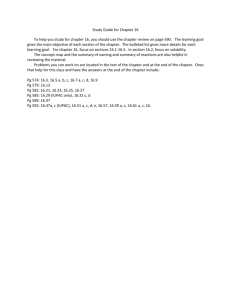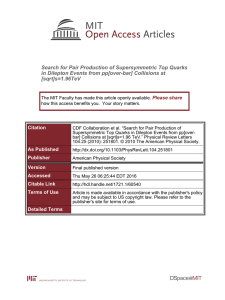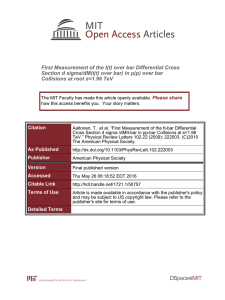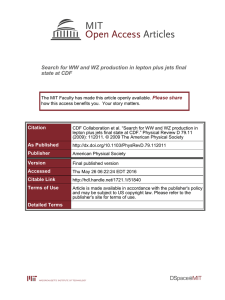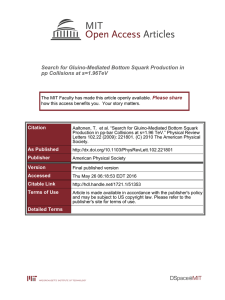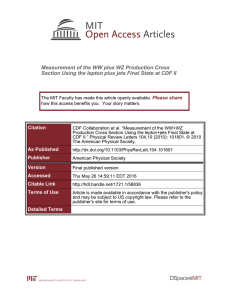Search for New Physics with a Dijet Plus Missing ET
advertisement
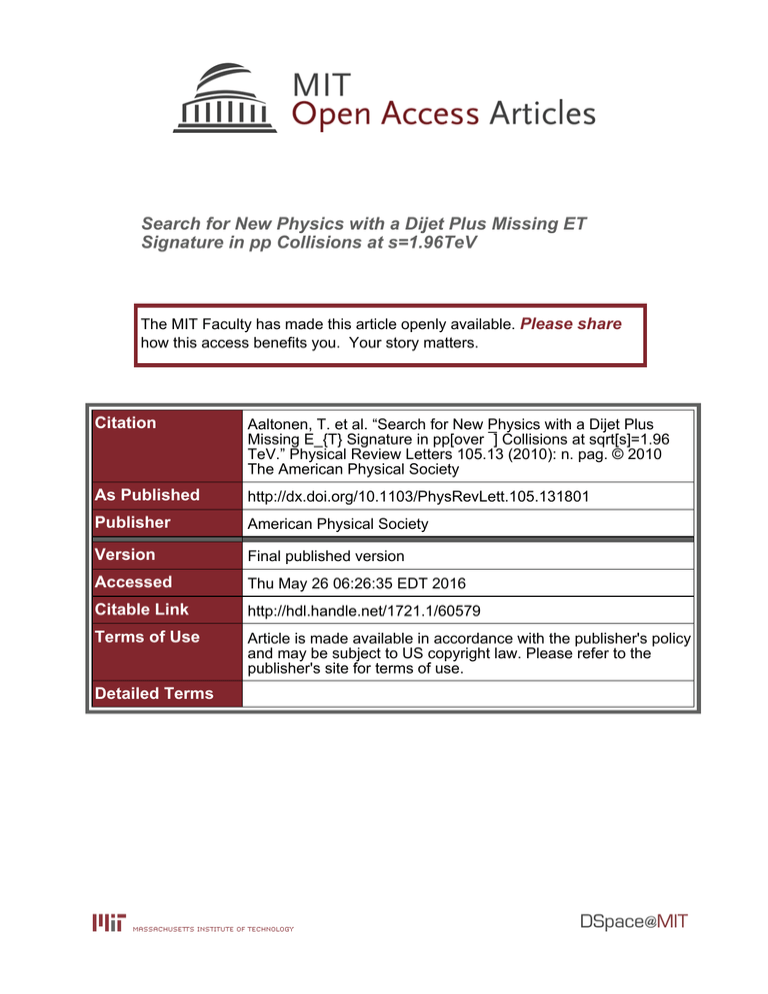
Search for New Physics with a Dijet Plus Missing ET
Signature in pp Collisions at s=1.96TeV
The MIT Faculty has made this article openly available. Please share
how this access benefits you. Your story matters.
Citation
Aaltonen, T. et al. “Search for New Physics with a Dijet Plus
Missing E_{T} Signature in pp[over ¯] Collisions at sqrt[s]=1.96
TeV.” Physical Review Letters 105.13 (2010): n. pag. © 2010
The American Physical Society
As Published
http://dx.doi.org/10.1103/PhysRevLett.105.131801
Publisher
American Physical Society
Version
Final published version
Accessed
Thu May 26 06:26:35 EDT 2016
Citable Link
http://hdl.handle.net/1721.1/60579
Terms of Use
Article is made available in accordance with the publisher's policy
and may be subject to US copyright law. Please refer to the
publisher's site for terms of use.
Detailed Terms
PRL 105, 131801 (2010)
PHYSICAL REVIEW LETTERS
week ending
24 SEPTEMBER 2010
Search for New Physics with a Dijet
pffiffiffi Plus Missing ET Signature in pp Collisions
at s ¼ 1:96 TeV
T. Aaltonen,24 J. Adelman,14 B. Álvarez González,12,w S. Amerio,44b,44a D. Amidei,35 A. Anastassov,39 A. Annovi,20
J. Antos,15 G. Apollinari,18 A. Apresyan,49 T. Arisawa,58 A. Artikov,16 J. Asaadi,54 W. Ashmanskas,18 A. Attal,4
A. Aurisano,54 F. Azfar,43 W. Badgett,18 A. Barbaro-Galtieri,29 V. E. Barnes,49 B. A. Barnett,26 P. Barria,47c,47a P. Bartos,15
G. Bauer,33 P.-H. Beauchemin,34 F. Bedeschi,47a D. Beecher,31 S. Behari,26 G. Bellettini,47b,47a J. Bellinger,60
D. Benjamin,17 A. Beretvas,18 A. Bhatti,51 M. Binkley,18 D. Bisello,44b,44a I. Bizjak,31,dd R. E. Blair,2 C. Blocker,7
B. Blumenfeld,26 A. Bocci,17 A. Bodek,50 V. Boisvert,50 D. Bortoletto,49 J. Boudreau,48 A. Boveia,11 B. Brau,11,b
A. Bridgeman,25 L. Brigliadori,6b,6a C. Bromberg,36 E. Brubaker,14 J. Budagov,16 H. S. Budd,50 S. Budd,25 K. Burkett,18
G. Busetto,44b,44a P. Bussey,22 A. Buzatu,34 K. L. Byrum,2 S. Cabrera,17,y C. Calancha,32 S. Camarda,4 M. Campanelli,36
M. Campbell,35 F. Canelli,14,18 A. Canepa,46 B. Carls,25 D. Carlsmith,60 R. Carosi,47a S. Carrillo,19,o S. Carron,18
B. Casal,12 M. Casarsa,18 A. Castro,6b,6a P. Catastini,47c,47a D. Cauz,55a V. Cavaliere,47c,47a M. Cavalli-Sforza,4 A. Cerri,29
L. Cerrito,31,r S. H. Chang,28 Y. C. Chen,1 M. Chertok,8 G. Chiarelli,47a G. Chlachidze,18 F. Chlebana,18 K. Cho,28
D. Chokheli,16 J. P. Chou,23 K. Chung,18,p W. H. Chung,60 Y. S. Chung,50 T. Chwalek,27 C. I. Ciobanu,45
M. A. Ciocci,47c,47a A. Clark,21 D. Clark,7 G. Compostella,44a M. E. Convery,18 J. Conway,8 M. Corbo,45 M. Cordelli,20
C. A. Cox,8 D. J. Cox,8 F. Crescioli,47b,47a C. Cuenca Almenar,61 J. Cuevas,12,w R. Culbertson,18 J. C. Cully,35
D. Dagenhart,18 M. Datta,18 T. Davies,22 P. de Barbaro,50 S. De Cecco,52a A. Deisher,29 G. De Lorenzo,4
M. Dell’Orso,47b,47a C. Deluca,4 L. Demortier,51 J. Deng,17,g M. Deninno,6a M. d’Errico,44b,44a P.-O. Deviveiros,34
A. Di Canto,47b,47a G. P. di Giovanni,45 B. Di Ruzza,47a J. R. Dittmann,5 M. D’Onofrio,4 S. Donati,47b,47a P. Dong,18
T. Dorigo,44a S. Dube,53 K. Ebina,58 A. Elagin,54 R. Erbacher,8 D. Errede,25 S. Errede,25 N. Ershaidat,45,cc R. Eusebi,54
H. C. Fang,29 S. Farrington,43 W. T. Fedorko,14 R. G. Feild,61 M. Feindt,27 J. P. Fernandez,32 C. Ferrazza,47d,47a R. Field,19
G. Flanagan,49,t R. Forrest,8 M. J. Frank,5 M. Franklin,23 J. C. Freeman,18 I. Furic,19 M. Gallinaro,51 J. Galyardt,13
F. Garberson,11 J. E. Garcia,21 A. F. Garfinkel,49 P. Garosi,47c,47a H. Gerberich,25 D. Gerdes,35 A. Gessler,27 S. Giagu,52b,52a
V. Giakoumopoulou,3 P. Giannetti,47a K. Gibson,48 J. L. Gimmell,50 C. M. Ginsburg,18 N. Giokaris,3 M. Giordani,55b,55a
P. Giromini,20 M. Giunta,47a G. Giurgiu,26 V. Glagolev,16 D. Glenzinski,18 M. Gold,38 N. Goldschmidt,19 A. Golossanov,18
G. Gomez,12 G. Gomez-Ceballos,33 M. Goncharov,33 O. González,32 I. Gorelov,38 A. T. Goshaw,17 K. Goulianos,51
A. Gresele,44b,44a S. Grinstein,4 C. Grosso-Pilcher,14 R. C. Group,18 U. Grundler,25 J. Guimaraes da Costa,23
Z. Gunay-Unalan,36 C. Haber,29 S. R. Hahn,18 E. Halkiadakis,53 B.-Y. Han,50 J. Y. Han,50 F. Happacher,20 K. Hara,56
D. Hare,53 M. Hare,57 R. F. Harr,59 M. Hartz,48 K. Hatakeyama,5 C. Hays,43 M. Heck,27 J. Heinrich,46 M. Herndon,60
J. Heuser,27 S. Hewamanage,5 D. Hidas,53 C. S. Hill,11,d D. Hirschbuehl,27 A. Hocker,18 S. Hou,1 M. Houlden,30
S.-C. Hsu,29 R. E. Hughes,40 M. Hurwitz,14 U. Husemann,61 M. Hussein,36 J. Huston,36 J. Incandela,11 G. Introzzi,47a
M. Iori,52b,52a A. Ivanov,8,q E. James,18 D. Jang,13 B. Jayatilaka,17 E. J. Jeon,28 M. K. Jha,6a S. Jindariani,18 W. Johnson,8
M. Jones,49 K. K. Joo,28 S. Y. Jun,13 J. E. Jung,28 T. R. Junk,18 T. Kamon,54 D. Kar,19 P. E. Karchin,59 Y. Kato,42,n
R. Kephart,18 W. Ketchum,14 J. Keung,46 V. Khotilovich,54 B. Kilminster,18 D. H. Kim,28 H. S. Kim,28 H. W. Kim,28
J. E. Kim,28 M. J. Kim,20 S. B. Kim,28 S. H. Kim,56 Y. K. Kim,14 N. Kimura,58 L. Kirsch,7 S. Klimenko,19 K. Kondo,58
D. J. Kong,28 J. Konigsberg,19 A. Korytov,19 A. V. Kotwal,17 M. Kreps,27 J. Kroll,46 D. Krop,14 N. Krumnack,5 M. Kruse,17
V. Krutelyov,11 T. Kuhr,27 N. P. Kulkarni,59 M. Kurata,56 S. Kwang,14 A. T. Laasanen,49 S. Lami,47a S. Lammel,18
M. Lancaster,31 R. L. Lander,8 K. Lannon,40,v A. Lath,53 G. Latino,47c,47a I. Lazzizzera,44b,44a T. LeCompte,2 E. Lee,54
H. S. Lee,14 J. S. Lee,28 S. W. Lee,54,x S. Leone,47a J. D. Lewis,18 C.-J. Lin,29 J. Linacre,43 M. Lindgren,18 E. Lipeles,46
A. Lister,21 D. O. Litvintsev,18 C. Liu,48 T. Liu,18 N. S. Lockyer,46 A. Loginov,61 L. Lovas,15 D. Lucchesi,44b,44a J. Lueck,27
P. Lujan,29 P. Lukens,18 G. Lungu,51 J. Lys,29 R. Lysak,15 D. MacQueen,34 R. Madrak,18 K. Maeshima,18 K. Makhoul,33
P. Maksimovic,26 S. Malde,43 S. Malik,31 G. Manca,30,f A. Manousakis-Katsikakis,3 F. Margaroli,49 C. Marino,27
C. P. Marino,25 A. Martin,61 V. Martin,22,l M. Martı́nez,4 R. Martı́nez-Balları́n,32 P. Mastrandrea,52a M. Mathis,26
M. E. Mattson,59 P. Mazzanti,6a K. S. McFarland,50 P. McIntyre,54 R. McNulty,30,k A. Mehta,30 P. Mehtala,24
A. Menzione,47a C. Mesropian,51 T. Miao,18 D. Mietlicki,35 N. Miladinovic,7 R. Miller,36 C. Mills,23 M. Milnik,27
A. Mitra,1 G. Mitselmakher,19 H. Miyake,56 S. Moed,23 N. Moggi,6a M. N. Mondragon,18,o C. S. Moon,28 R. Moore,18
M. J. Morello,47a J. Morlock,27 P. Movilla Fernandez,18 J. Mülmenstädt,29 A. Mukherjee,18 Th. Muller,27 P. Murat,18
M. Mussini,6b,6a J. Nachtman,18,p Y. Nagai,56 J. Naganoma,56 K. Nakamura,56 I. Nakano,41 A. Napier,57 J. Nett,60
C. Neu,46,aa M. S. Neubauer,25 S. Neubauer,27 J. Nielsen,29,h L. Nodulman,2 M. Norman,10 O. Norniella,25 E. Nurse,31
0031-9007=10=105(13)=131801(8)
131801-1
Ó 2010 The American Physical Society
PRL 105, 131801 (2010)
PHYSICAL REVIEW LETTERS
week ending
24 SEPTEMBER 2010
L. Oakes,43 S. H. Oh,17 Y. D. Oh,28 I. Oksuzian,19 T. Okusawa,42 R. Orava,24 K. Osterberg,24 S. Pagan Griso,44b,44a
C. Pagliarone,55a E. Palencia,18 V. Papadimitriou,18 A. Papaikonomou,27 A. A. Paramanov,2 B. Parks,40 S. Pashapour,34
J. Patrick,18 G. Pauletta,55b,55a M. Paulini,13 C. Paus,33 T. Peiffer,27 D. E. Pellett,8 A. Penzo,55a T. J. Phillips,17
G. Piacentino,47a E. Pianori,46 L. Pinera,19 K. Pitts,25 C. Plager,9 L. Pondrom,60 K. Potamianos,49 O. Poukhov,16,a
F. Prokoshin,16,z A. Pronko,18 F. Ptohos,18,j E. Pueschel,13 G. Punzi,47b,47a J. Pursley,60 J. Rademacker,43,d A. Rahaman,48
V. Ramakrishnan,60 N. Ranjan,49 I. Redondo,32 P. Renton,43 M. Renz,27 M. Rescigno,52a S. Richter,27 F. Rimondi,6b,6a
L. Ristori,47a A. Robson,22 T. Rodrigo,12 T. Rodriguez,46 E. Rogers,25 S. Rolli,57 R. Roser,18 M. Rossi,55a R. Rossin,11
P. Roy,34 A. Ruiz,12 J. Russ,13 V. Rusu,18 B. Rutherford,18 H. Saarikko,24 A. Safonov,54 W. K. Sakumoto,50 L. Santi,55b,55a
L. Sartori,47a K. Sato,56 P. Savard,34 A. Savoy-Navarro,45 P. Schlabach,18 A. Schmidt,27 E. E. Schmidt,18 M. A. Schmidt,14
M. P. Schmidt,61,a M. Schmitt,39 T. Schwarz,8 L. Scodellaro,12 A. Scribano,47c,47a F. Scuri,47a A. Sedov,49 S. Seidel,38
Y. Seiya,42 A. Semenov,16 L. Sexton-Kennedy,18 F. Sforza,47b,47a A. Sfyrla,25 S. Z. Shalhout,59 T. Shears,30 P. F. Shepard,48
M. Shimojima,56,u S. Shiraishi,14 M. Shochet,14 Y. Shon,60 I. Shreyber,37 A. Simonenko,16 P. Sinervo,34 A. Sisakyan,16
A. J. Slaughter,18 J. Slaunwhite,40 K. Sliwa,57 J. R. Smith,8 F. D. Snider,18 R. Snihur,34 A. Soha,18 S. Somalwar,53 V. Sorin,4
P. Squillacioti,47c,47a M. Stanitzki,61 R. St. Denis,22 B. Stelzer,34 O. Stelzer-Chilton,34 D. Stentz,39 J. Strologas,38
G. L. Strycker,35 J. S. Suh,28 A. Sukhanov,19 I. Suslov,16 A. Taffard,25,g R. Takashima,41 Y. Takeuchi,56 R. Tanaka,41
J. Tang,14 M. Tecchio,35 P. K. Teng,1 J. Thom,18,i J. Thome,13 G. A. Thompson,25 E. Thomson,46 P. Tipton,61
P. Ttito-Guzmán,32 S. Tkaczyk,18 D. Toback,54 S. Tokar,15 K. Tollefson,36 T. Tomura,56 D. Tonelli,18 S. Torre,20
D. Torretta,18 P. Totaro,55b,55a S. Tourneur,45 M. Trovato,47d,47a S.-Y. Tsai,1 Y. Tu,46 N. Turini,47c,47a F. Ukegawa,56
S. Uozumi,28 N. van Remortel,24,c A. Varganov,35 E. Vataga,47d,47a F. Vázquez,19,o G. Velev,18 C. Vellidis,3 M. Vidal,32
I. Vila,12 R. Vilar,12 M. Vogel,38 I. Volobouev,29,x G. Volpi,47b,47a P. Wagner,46 R. G. Wagner,2 R. L. Wagner,18
W. Wagner,27,bb J. Wagner-Kuhr,27 T. Wakisaka,42 R. Wallny,9 S. M. Wang,1 A. Warburton,34 D. Waters,31
M. Weinberger,54 J. Weinelt,27 W. C. Wester III,18 B. Whitehouse,57 D. Whiteson,46,g A. B. Wicklund,2 E. Wicklund,18
S. Wilbur,14 G. Williams,34 H. H. Williams,46 P. Wilson,18 B. L. Winer,40 P. Wittich,18,i S. Wolbers,18 C. Wolfe,14
H. Wolfe,40 T. Wright,35 X. Wu,21 F. Würthwein,10 A. Yagil,10 K. Yamamoto,42 J. Yamaoka,17 U. K. Yang,14,s Y. C. Yang,28
W. M. Yao,29 G. P. Yeh,18 K. Yi,18,p J. Yoh,18 K. Yorita,58 T. Yoshida,42,m G. B. Yu,17 I. Yu,28 S. S. Yu,18 J. C. Yun,18
A. Zanetti,55a Y. Zeng,17 X. Zhang,25 Y. Zheng,9,e and S. Zucchelli6b,6a
(CDF Collaboration)
1
Institute of Physics, Academia Sinica, Taipei, Taiwan 11529, Republic of China
2
Argonne National Laboratory, Argonne, Illinois 60439, USA
3
University of Athens, 157 71 Athens, Greece
4
Institut de Fisica d’Altes Energies, Universitat Autonoma de Barcelona, E-08193, Bellaterra (Barcelona), Spain
5
Baylor University, Waco, Texas 76798, USA
6a
Istituto Nazionale di Fisica Nucleare Bologna, I-40127 Bologna, Italy
6b
University of Bologna, I-40127 Bologna, Italy
7
Brandeis University, Waltham, Massachusetts 02254, USA
8
University of California, Davis, Davis, California 95616, USA
9
University of California, Los Angeles, Los Angeles, California 90024, USA
10
University of California, San Diego, La Jolla, California 92093, USA
11
University of California, Santa Barbara, Santa Barbara, California 93106, USA
12
Instituto de Fisica de Cantabria, CSIC-University of Cantabria, 39005 Santander, Spain
13
Carnegie Mellon University, Pittsburgh, Pennsylvania 15213, USA
14
Enrico Fermi Institute, University of Chicago, Chicago, Illinois 60637, USA
15
Comenius University, 842 48 Bratislava, Slovakia; Institute of Experimental Physics, 040 01 Kosice, Slovakia
16
Joint Institute for Nuclear Research, RU-141980 Dubna, Russia
17
Duke University, Durham, North Carolina 27708, USA
18
Fermi National Accelerator Laboratory, Batavia, Illinois 60510, USA
19
University of Florida, Gainesville, Florida 32611, USA
20
Laboratori Nazionali di Frascati, Istituto Nazionale di Fisica Nucleare, I-00044 Frascati, Italy
21
University of Geneva, CH-1211 Geneva 4, Switzerland
22
Glasgow University, Glasgow G12 8QQ, United Kingdom
23
Harvard University, Cambridge, Massachusetts 02138, USA
24
Division of High Energy Physics, Department of Physics, University of Helsinki and Helsinki Institute of Physics,
FIN-00014, Helsinki, Finland
131801-2
PRL 105, 131801 (2010)
PHYSICAL REVIEW LETTERS
week ending
24 SEPTEMBER 2010
25
University of Illinois, Urbana, Illinois 61801, USA
The Johns Hopkins University, Baltimore, Maryland 21218, USA
27
Institut für Experimentelle Kernphysik, Karlsruhe Institute of Technology, D-76131 Karlsruhe, Germany
28
Center for High Energy Physics: Kyungpook National University, Daegu 702-701, Korea;
Seoul National University, Seoul 151-742, Korea; Sungkyunkwan University, Suwon 440-746, Korea;
Korea Institute of Science and Technology Information, Daejeon 305-806, Korea;
Chonnam National University, Gwangju 500-757, Korea; Chonbuk National University, Jeonju 561-756, Korea
29
Ernest Orlando Lawrence Berkeley National Laboratory, Berkeley, California 94720, USA
30
University of Liverpool, Liverpool L69 7ZE, United Kingdom
31
University College London, London WC1E 6BT, United Kingdom
32
Centro de Investigaciones Energeticas Medioambientales y Tecnologicas, E-28040 Madrid, Spain
33
Massachusetts Institute of Technology, Cambridge, Massachusetts 02139, USA
34
Institute of Particle Physics: McGill University, Montréal, Québec, Canada H3A 2T8;
Simon Fraser University, Burnaby, British Columbia, Canada V5A 1S6;
University of Toronto, Toronto, Ontario, Canada M5S 1A7;
and TRIUMF, Vancouver, British Columbia, Canada V6T 2A3
35
University of Michigan, Ann Arbor, Michigan 48109, USA
36
Michigan State University, East Lansing, Michigan 48824, USA
37
Institution for Theoretical and Experimental Physics, ITEP, Moscow 117259, Russia
38
University of New Mexico, Albuquerque, New Mexico 87131, USA
39
Northwestern University, Evanston, Illinois 60208, USA
40
The Ohio State University, Columbus, Ohio 43210, USA
41
Okayama University, Okayama 700-8530, Japan
42
Osaka City University, Osaka 588, Japan
43
University of Oxford, Oxford OX1 3RH, United Kingdom
44a
Istituto Nazionale di Fisica Nucleare, Sezione di Padova-Trento,
I-35131 Padova, Italy
44b
University of Padova, I-35131 Padova, Italy
45
LPNHE, Universite Pierre et Marie Curie/IN2P3-CNRS, UMR7585, Paris, F-75252 France
46
University of Pennsylvania, Philadelphia, Pennsylvania 19104, USA
47a
Istituto Nazionale di Fisica Nucleare Pisa, I-56127 Pisa, Italy
47b
University of Pisa, I-56127 Pisa, Italy
47c
University of Siena, I-56127 Pisa, Italy
47d
Scuola Normale Superiore, I-56127 Pisa, Italy
48
University of Pittsburgh, Pittsburgh, Pennsylvania 15260, USA
49
Purdue University, West Lafayette, Indiana 47907, USA
50
University of Rochester, Rochester, New York 14627, USA
51
The Rockefeller University, New York, New York 10021, USA
52a
Istituto Nazionale di Fisica Nucleare, Sezione di Roma 1, I-00185 Roma, Italy
52b
Sapienza Università di Roma, I-00185 Roma, Italy
53
Rutgers University, Piscataway, New Jersey 08855, USA
54
Texas A&M University, College Station, Texas 77843, USA
55a
Istituto Nazionale di Fisica Nucleare Trieste/Udine, I-34100 Trieste, Italy
55b
University of Trieste/Udine, I-33100 Udine, Italy
56
University of Tsukuba, Tsukuba, Ibaraki 305, Japan
57
Tufts University, Medford, Massachusetts 02155, USA
58
Waseda University, Tokyo 169, Japan
59
Wayne State University, Detroit, Michigan 48201, USA
60
University of Wisconsin, Madison, Wisconsin 53706, USA
61
Yale University, New Haven, Connecticut 06520, USA
(Received 4 February 2010; revised manuscript received 17 August 2010; published 20 September 2010)
26
We present results of a signature-based search for new physics using a dijet plus missing transverse
pffiffiffi
energy (ET ) data sample collected in 2 fb1 of pp collisions at s ¼ 1:96 TeV with the CDF II detector
at the Fermilab Tevatron. We observe no significant event excess with respect to the standard model
prediction and extract a 95% C.L. upper limit on the cross section times acceptance for a potential
contribution from a nonstandard model process. The search is made by using novel, data-driven
techniques for estimating backgrounds that are applicable to first searches at the LHC.
DOI: 10.1103/PhysRevLett.105.131801
PACS numbers: 13.85.Rm, 14.80.Sv
131801-3
PRL 105, 131801 (2010)
PHYSICAL REVIEW LETTERS
Events featuring two energetic jets and significant missing transverse energy (ET ) [1] are a potential signature for
phenomena not included in the standard model (SM), such
as supersymmetry [2], universal extra dimensions [3], and
leptoquark production [4]. In general, any model predicting pair production of unstable particles whose decay
products are a single parton and a noninteracting particle
could be observable as an event excess above the SM
expectation in the dijet þ ET channel. In this Letter, we
report on a signature-based search for new physics contributions to the dijet þ ET final
pffiffiffistate in CDF run II data
collected in pp collisions at s ¼ 1:96 TeV corresponding to an integrated luminosity of 2 fb1 . This search
features newly developed techniques for obtaining datadriven predictions of SM background contributions to the
search samples. These techniques evade large systematic
uncertainties inherent in Monte Carlo–based background
estimates such as those affiliated with the modeling of jet
energy scale and resolution.
In contrast with previous CDF [5] and D0 [6] searches in
this final state, no a priori optimization of the kinematic
selection criteria is performed to maximize sensitivity to a
particular model. Here the criteria are chosen to encompass
the widest possible kinematic range consistent with the
trigger used to collect the data sample. We perform a
simple counting experiment on this inclusive sample, comparing the number of observed events against the SM
expectation, to search for indications of potential non-SM
contributions. A second, analogous counting experiment is
made on a subsample of the highest energy events from
within the inclusive sample, which is more sensitive to
some classes of non-SM production processes. The tighter
kinematic selections that define this event subset are
chosen to give a fixed (15%) uncertainty on the data-driven
SM background prediction made for this sample. From
here forward, we refer to these sets of candidate events
as our loose and tight samples. Based on the counting
experiment results, we place 95% C.L. upper limits on
the cross section times acceptance ( A) for a generic,
non-SM process that contributes events to the candidate
samples. Finally, we use the generic limit on A to
extract a lower limit on leptoquark mass for the specific
case of scalar leptoquark production, which serves as a
sensitivity benchmark for the result.
A detailed description of the CDF II detector can be
found in Ref. [7]. The data sample was collected by using a
three-level trigger system based on a minimum ET requirement of 45 GeV. Reconstructed candidate events are required to have ET > 80 GeV to ensure full trigger
efficiency. Jets are reconstructed from energy deposits in
the calorimeter by using a cone-based algorithm with fixed
radius of 0.7 in space. The measured jet ET is
corrected for detector effects and contributions from multiple pp interactions per bunch crossing [8]. Events in the
candidate samples are required to have two reconstructed
week ending
24 SEPTEMBER 2010
jets with jj < 2:4 and ET > 30 GeV and no additional
jets with jj < 3:6 and ET > 15 GeV. In addition, the
scalar sum of the two jet transverse energies, HT ¼
ET ðjet 1Þ þ ET ðjet 2Þ, must be greater than 125 GeV. A
separation of at least 0.5 radians in azimuthal angle is
required between the ET and both jets to help suppress
multijet background events containing significant ET from
poorly measured jets. Events from beam-related backgrounds and cosmic rays are removed by using standard
criteria [9] to tag reconstructed tracks and jets inconsistent
with having been produced by particles originating from
pp collisions. The subset of events that satisfy tighter
kinematic thresholds of ET > 100 GeV and HT >
225 GeV define the tight candidate sample.
Several SM processes capable of producing a high ET
signature in our detector contribute events to our candidate
samples. The largest SM background is Z þ jets where the
Z boson decays into a pair of neutrinos. This process
results in a signature indistinguishable from that of potential signal, and its relative contribution to the candidate
samples is therefore irreducible. The next most significant
SM contribution is from W þ jets in which the W decays
via a charged lepton (e, , or ) and neutrino. We suppress
this background by rejecting events that contain either an
isolated track [9] with pT > 10 GeV=c ( or candidate)
or a jet with ET > 15 GeV and electromagnetic energy
fraction above 90% (e candidate).
The W=Z þ jets backgrounds are modeled by using
separate data samples collected with single lepton triggers.
We estimate the number of background events from
W=Z þ jets production in our dijet þ ET candidate
samples by using cross section measurements obtained
from Zð! ‘‘Þ þ jets and Wð! ‘Þ þ jets (‘ ¼ e or )
events with fully reconstructed leptons. The measured
cross sections contain contributions from diboson production where two jets are produced in the hadronic decay of
the second boson, and potential diboson contributions to
the dijet þ ET samples are therefore included within the
resulting background estimates. Events in the samples
used to make these measurements are required to have at
least one electron (ET > 25 GeV) or one muon (pT >
20 GeV=c) passing standard selection criteria [7]. We
select W ! ‘ candidates by requiring ET > 25 GeV
(ET > 20 GeV) for electrons (muons) and Z ! ‘‘ candidates by requiring a second lepton satisfying a looser set
of selection criteria [7]. We then apply the full set of
dijet þ ET selections described previously to the selected
W=Z candidates to obtain Wð! ‘Þ þ jets and Zð! ‘‘Þ þ
jets event samples. To be consistent with the criteria used
in selecting dijet þ ET signal events, reconstructed tracks
and calorimeter energy deposits associated with the
charged lepton(s) are removed prior to application of the
isolated track veto and ET requirements.
To extract W=Z þ jets cross sections from
these samples, we correct for the acceptance of
131801-4
PRL 105, 131801 (2010)
week ending
24 SEPTEMBER 2010
PHYSICAL REVIEW LETTERS
the W ! ‘ (25%–32%) or Z ! ‘‘ (15%–33%) pieces of
the selection criteria by using simulated ALPGEN [10]
events run through a full detector simulation based
on Ref. [11]. Acceptances depend on the specific lepton
(‘ ¼ e or ) decay channel and the associated loose or
tight dijet þ ET selection criteria. To account for observed
differences in lepton reconstruction and identification efficiencies between data and simulation, corrections of up to
10% per lepton are applied to the simulated acceptances.
Uncertainties on these efficiency corrections are small
( 1%–2%) compared with those coming from candidate
sample statistics and the methods used to estimate sample
background contributions. The observed agreement in the
cross section measurements made by using high-statistics
Wð! eÞ þ jets and Wð! Þ þ jets candidate samples
provides validation of the techniques used to estimate
W ! ‘ background contributions. To minimize statistical
uncertainties, cross sections used to estimate backgrounds
are combined measurements from both lepton decay
channels.
Estimates of dijet þ ET candidate sample backgrounds
from Z þ jets production, in which the Z boson decays to
neutrinos, are taken directly from measured Zð! ‘‘Þ þ
jets cross sections based on the difference in Z branching
ratios for charged leptons and neutrinos. A second, independent background estimate is obtained from measured
Wð! ‘Þ þ jets cross sections incorporating a theoretical
prediction for RðW=ZÞ , the ratio of W þ jets and Z þ jets
production cross sections. We determine RðW=ZÞ with a
next-to-leading order (NLO) calculation by using the
MCFM generator [12]. The value of RðW=ZÞ , which depends
on the specific choice of jet requirements, is calculated to
be 8:7 0:2 (8:2 0:2) for the loose (tight) dijet þ ET
sample. Final background estimates are obtained by combining the two statistically independent, consistent results.
Similarly, measured Wð! ‘Þ þ jets cross sections are
used to extract W þ jets background estimates for the
dijet þ ET candidate samples. The probability for the
charged lepton in these events to fail the lepton veto criteria
is obtained from simulation ( 20% for electrons, 33%
for muons, and 55% for taus) and applied as an acceptance factor on the measured cross section. Smaller backgrounds from Z þ jets, where the Z boson decays into a
pair of charged leptons that both fail lepton veto criteria,
are estimated from measured Zð! ‘‘Þ þ jets cross sections by using the same technique. Since the same measured cross sections are used to estimate all W=Z þ jets
backgrounds, uncertainties on these predictions are fully
correlated. Small event contributions from tt and singletop production are obtained directly from simulation. We
use a measured run II cross section [13] for tt and a NLO
cross section calculation [14] for single-top production to
normalize these estimates.
The dominant multijet topology contributing events to
our candidate samples is three-jet events in which the third
jet is either not reconstructed or has an ET below our jet
threshold (15 GeV). The magnitude of this background is
estimated from data by using three-jet events in which the
observed ET points in the direction of the least-energetic
jet. We perform a linear extrapolation of the ET distribution
obtained from the least-energetic jets in these events into
the region where the ET falls below the threshold for
defining jets. A large sample of multijet events simulated
with PYTHIA [15] is used to establish the validity of the
technique. Before performing the extrapolation, corrections obtained from simulation are applied to the distribution to remove W=Z þ jets contributions. The same
simulated PYTHIA event sample is used to determine the
relative fraction of events originating from other multijet
topologies (20%), and the background estimates obtained
from three-jet data are scaled by this factor to incorporate
all contributions. We assign a conservative 100% uncertainty to this scale factor that minimally affects combined
uncertainties on the multijet background estimates, which
are dominated by the small statistics of the three-jet
candidate samples.
Background contributions from the process in which a
photon is produced in association with jets are obtained
from a simulated event sample generated with PYTHIA. The
estimates are normalized by using a run II D0 measurement
of the þ jets cross section [16]. The uncertainty on this
measurement is the leading source of uncertainty on the
þ jets background estimates. Finally, the small, residual
noncollision background is estimated by using timing information from the hadronic calorimeter.
Estimated SM backgrounds and the number of observed
events for the loose and tight dijet þ ET candidate samples
are shown in Table I. The dominant uncertainty source on
the combined SM background predictions is the statistical
size of the Wð! ‘Þ þ jets and Zð! ‘‘Þ þ jets candidate samples (4.6% and 12.2% on the total background
estimates for the loose and tight samples, respectively).
Other non-negligible uncertainty contributions are from
TABLE I. Estimated SM backgrounds and the number of
observed data events for loose (HT > 125 GeV, ET > 80 GeV)
and tight (HT > 225 GeV, ET > 100 GeV) candidate samples.
Background
Z ! W ! W ! W ! e
Z ! ‘‘
Top quark production
Multijet production
þ jets
Noncollision
Total expected
Data observed
131801-5
Loose sample
Tight sample
888 54
669 42
399 25
256 16
29 4
74 9
49 30
75 11
44
2443 151
2506
86:4 12:7
50:6 8:0
32:9 5:2
14:0 2:2
1:7 0:2
10:8 1:7
9:0 9:0
4:8 1:1
1:0 1:0
211:2 29:8
186
PRL 105, 131801 (2010)
background estimates used in the Wð! ‘Þ þ jets and
Zð! ‘‘Þ þ jets cross section measurements (2.4% and
4.0%), input parameters to the theoretical calculation of
RðW=ZÞ (1.8% and 1.8%), and statistics of the three-jet
samples used to perform the linear extrapolation for determining multijet backgrounds (1.2% and 4.3%). Final combined uncertainties on predicted SM backgrounds for the
loose and tight candidate samples are 6.2% and 14.1%. As
illustrated in Fig. 1, the data-driven background model is
further validated by using the Wð! ‘Þ þ jets candidate
samples to predict kinematic distributions obtained from
dijet þ ET candidate events. Correct missing ET models
are obtained for each specific background contribution by
removing lepton energy deposits not contained within
dijet þ ET candidate events originating from that process.
We observe no significant excess in data relative to SM
predictions in either the loose or tight candidate samples
constraining potential contributions from new physics processes. An upper limit on the number of non-SM signal
events contained within each sample is obtained by using a
Bayesian approach with a flat prior for the number of
signal events and priors based on gamma distributions for
both the acceptance and number of SM background events
[17]. These limits are directly translatable into upper limits
on A for any new physics process that contributes
events to our candidate samples. The limits do not assume
central values for signal acceptance, which is detectordependent and varies significantly for different processes.
Quoted limits are based on specific choices for acceptance
uncertainties, which vary less among the different processes. For a 15% signal acceptance uncertainty we obtain
a 95% C.L. upper limit of 0.18 pb (0.02 pb) on A for
the loose (tight) candidate sample. Increasing the signal
acceptance uncertainty by a factor of 2 leads to a 25%
degradation in the quoted limits.
For the case of scalar leptoquark pair production where
each leptoquark decays into a quark and a neutrino, we
103
provide an example of the detector-dependent acceptance
calculation required to extract model limits. We simulate
signal acceptance by using PYTHIA in conjunction with a
full detector simulation. The loose (tight) dijet þ ET selection criteria yield an acceptance of 14% (4%) to a firstgeneration leptoquark with a mass of 150 GeV=c2 .
Acceptance increases as a function of leptoquark mass
(MLQ ), rising to 20% (9%) at 200 GeV=c2 . The relative
acceptance uncertainty is 13% (20%) independent of MLQ
and comes from potential variations in parton distribution
functions (PDFs), ambiguity in the absolute jet energy
scale [8], modeling of initial and final state radiation,
data sample luminosity, and selection efficiencies. Mass
limits are based on a NLO production cross section calculation [18] by using the CTEQ6.1M PDF set [19] and
¼ MLQ for the renormalization and factorization scales.
Cross section uncertainties due to PDF modeling (from the
full set of CTEQ6.1M eigenvectors) and scale choice (from
varying between MLQ =2 and 2 MLQ ) are added in
quadrature. We determine the sample with best a priori
sensitivity to the leptoquark model at each mass point and
set a 95% C.L. lower mass limit based on where the cross
section limit from the more sensitive sample intersects the
lower uncertainty band of the NLO calculation. Figure 2
shows the cross section limits as a function of leptoquark
mass, which result in lower mass limits of 187 GeV=c2 for
first- and second-generation q scalar leptoquarks (corresponding to an upper cross section limit of 0.33 pb at this
mass point). This result significantly improves upon the
previous CDF limit [5] and is only slightly looser than the
D0 lower mass limit of 205 GeV=c2 [6] obtained from an
optimized search on a 25% larger data sample.
In summary, this Letter presents a signature-based
search for potential non-SM contributions to the
dijet þ ET final state. New techniques for obtaining datadriven estimates of SM background contributions to the
search samples are described. These techniques, which
circumvent uncertainties intrinsic to Monte Carlo models,
Data
Z→νν + jets Model
10
3
W→lν + jets Model
102
NLO Calculation
Model for other Backgrounds
Cross-section (pb)
Events / 20 GeV
week ending
24 SEPTEMBER 2010
PHYSICAL REVIEW LETTERS
10
1
102
Observed Limit
Expected Limit
10
From Tight Sample
1
From Loose Sample
150
200
250
300
350
400
450
500
550
600
10-1
Jet Scalar HT (GeV)
60
80
100
120
140
160
180
200
2
Leptoquark Mass (GeV/c )
FIG. 1 (color online). Scalar sum of jet transverse energies
(HT ) for events in the loose dijet þ ET candidate sample compared against the predicted distribution from the data-driven
background model.
FIG. 2 (color online). 95% C.L. upper cross section limits on
first- and second-generation q scalar leptoquark pair production
(q being u, d, s, or c) as a function of leptoquark mass (MLQ ).
131801-6
PRL 105, 131801 (2010)
PHYSICAL REVIEW LETTERS
are favored for first LHC searches in these channels. No
data excess is observed, and we set a 95% C.L. upper limit
on the cross section times acceptance for potential non-SM
production processes. For the specific case of first- and
second-generation scalar leptoquark production, we obtain
a 95% C.L. lower mass limit of 187 GeV=c2 .
We thank M. Krämer for providing next-to-leading order
leptoquark production cross sections. We thank Fermilab
staff and the technical staffs of the participating institutions
for their vital contributions. This work was supported by
the U.S. Department of Energy and National Science
Foundation; the Italian Istituto Nazionale di Fisica
Nucleare; the Ministry of Education, Culture, Sports,
Science and Technology of Japan; the Natural Sciences
and Engineering Research Council of Canada; the National
Science Council of the Republic of China; the Swiss
National Science Foundation; the A. P. Sloan Foundation;
the Bundesministerium für Bildung und Forschung,
Germany; the World Class University Program, the
National Research Foundation of Korea; the Science and
Technology Facilities Council and the Royal Society,
United Kingdom; the Institut National de Physique
Nucleaire et Physique des Particules/CNRS; the Russian
Foundation for Basic Research; the Ministerio de Ciencia e
Innovación, and Programa Consolider-Ingenio 2010,
Spain; the Slovak R&D Agency; and the Academy of
Finland.
a
Deceased.
Visitor from University of Massachusetts Amherst,
Amherst, MA 01003, USA.
c
Visitor from Universiteit Antwerpen, B-2610 Antwerp,
Belgium.
d
Visitor from University of Bristol, Bristol BS8 1TL,
United Kingdom.
e
Visitor from Chinese Academy of Sciences, Beijing
100864, China.
f
Visitor from Istituto Nazionale di Fisica Nucleare, Sezione
di Cagliari, 09042 Monserrato (Cagliari), Italy.
g
Visitor from University of California Irvine, Irvine, CA
92697, USA.
h
Visitor from University of California Santa Cruz, Santa
Cruz, CA 95064, USA.
i
Visitor from Cornell University, Ithaca, NY 14853, USA.
j
Visitor from University of Cyprus, Nicosia CY-1678,
Cyprus.
k
Visitor from University College Dublin, Dublin 4, Ireland.
l
Visitor from University of Edinburgh, Edinburgh EH9
3JZ, United Kingdom.
m
Visitor from University of Fukui, Fukui City, Fukui
Prefecture, Japan 910-0017.
n
Visitor from Kinki University, Higashi-Osaka City, Japan
577-8502.
o
Visitor from Universidad Iberoamericana, Mexico D.F.,
Mexico.
b
p
week ending
24 SEPTEMBER 2010
Visitor from University of Iowa, Iowa City, IA 52242, USA.
Visitor from Kansas State University, Manhattan, KS
66506, USA.
r
Visitor from Queen Mary, University of London, London,
E1 4NS, United Kingdom.
s
Visitor from University of Manchester, Manchester M13
9PL, United Kingdom.
t
Visitor from Muons, Inc., Batavia, IL 60510, USA.
u
Visitor from Nagasaki Institute of Applied Science,
Nagasaki, Japan.
v
Visitor from University of Notre Dame, Notre Dame, IN
46556, USA.
w
Visitor from University de Oviedo, E-33007 Oviedo,
Spain.
x
Visitor from Texas Tech University, Lubbock, TX 79609,
USA.
y
Visitor from IFIC(CSIC-Universitat de Valencia), 56071
Valencia, Spain.
z
Visitor from Universidad Tecnica Federico Santa Maria,
110v Valparaiso, Chile.
aa
Visitor from University of Virginia, Charlottesville, VA
22906, USA.
bb
Visitor from Bergische Universität Wuppertal, 42097
Wuppertal, Germany.
cc
Visitor from Yarmouk University, Irbid 211-63, Jordan.
dd
On leave from J. Stefan Institute, Ljubljana, Slovenia.
[1] We use a coordinate system where is the polar angle to
the proton beam, is the azimuthal angle about this beam
axis, and is the pseudorapidity defined as lntanð=2Þ.
Missing
P transverse energy ET is defined as the magnitude
of i EiT n^ i , where n^ i is a unit vector in the azimuthal
plane that points from the beam line to the ith calorimeter
tower and EiT is the transverse component of the measured
energy in the tower, defined as Ei sin.
[2] G. L. Kane and J. P. Leville, Phys. Lett. 112B, 227 (1982);
P. R. Harrison and C. H. Llewellyn-Smith, Nucl. Phys.
B213, 223 (1983).
[3] C. Macesanu, Int. J. Mod. Phys. A 21, 2259 (2006).
[4] J. L. Hewett and T. G. Rizzo, Phys. Rev. D 56, 5709
(1997); M. Krämer, T. Plehn, M. Spira, and P. M.
Zerwas, Phys. Rev. Lett. 79, 341 (1997).
[5] D. Acosta et al. (CDF Collaboration), Phys. Rev. D 72,
051107 (2005); T. Aaltonen et al. (CDF Collaboration),
Phys. Rev. Lett. 102, 121801 (2009).
[6] V. M. Abazov et al. (D0 Collaboration), Phys. Lett. B 668,
357 (2008); V. M. Abazov et al. (D0 Collaboration), Phys.
Lett. B 660, 449 (2008).
[7] A. Abulencia et al. (CDF Collaboration), J. Phys. G 34,
2457 (2007).
[8] A. Bhatti et al., Nucl. Instrum. Methods Phys. Res., Sect.
A 566, 375 (2006).
[9] A. Abulencia et al. (CDF Collaboration), Phys. Rev. Lett.
97, 171802 (2006).
[10] M. L. Mangano et al., J. High Energy Phys. 07 (2003) 001.
[11] R. Brun et al., Technical Report No. CERN-DD/EE/84-1,
1987; S. Agostinelli et al., Nucl. Instrum. Methods Phys.
Res., Sect. A 506, 250 (2003).
[12] John Campbell and R. K. Ellis, Phys. Rev. D 65, 113007
(2002).
131801-7
q
PRL 105, 131801 (2010)
PHYSICAL REVIEW LETTERS
[13] A. Abulencia et al. (CDF Collaboration), Phys. Rev. Lett.
97, 082004 (2006).
[14] B. W. Harris et al., Phys. Rev. D 66, 054024 (2002); Z.
Sullivan, Phys. Rev. D 70, 114012 (2004).
[15] T. Sjöstrand et al., Comput. Phys. Commun. 135, 238
(2001).
week ending
24 SEPTEMBER 2010
[16] V. M. Abazov et al. (D0 Collaboration), Phys. Lett. B 639,
151 (2006).
[17] J. Heinrich et al., arXiv:physics/0409129.
[18] M. Krämer et al., Phys. Rev. Lett. 79, 341 (1997).
[19] J. Pumplin et al., J. High Energy Phys. 07 (2002) 012; D.
Stump et al., J. High Energy Phys. 10 (2003) 046.
131801-8

